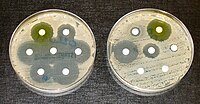
Photo from wikipedia
BACKGROUND Antimicrobial susceptibility testing (AST) is classically performed using growth-based techniques that essentially require viable bacterial matter to become visible to the naked eye or a sophisticated densitometer. CONTENT Technologies… Click to show full abstract
BACKGROUND Antimicrobial susceptibility testing (AST) is classically performed using growth-based techniques that essentially require viable bacterial matter to become visible to the naked eye or a sophisticated densitometer. CONTENT Technologies based on the measurement of bacterial density in suspension have evolved marginally in accuracy and rapidity over the 20th century, but assays expanded for new combinations of bacteria and antimicrobials have been automated, and made amenable to high-throughput turn-around. Over the past 25 years, elevated AST rapidity has been provided by nucleic acid-mediated amplification technologies, proteomic and other "omic" methodologies, and the use of next-generation sequencing. In rare cases, AST at the level of single-cell visualization was developed. This has not yet led to major changes in routine high-throughput clinical microbiological detection of antimicrobial resistance. SUMMARY We here present a review of the new generation of methods and describe what is still urgently needed for their implementation in day-to-day management of the treatment of infectious diseases.
Journal Title: Clinical chemistry
Year Published: 2021
Link to full text (if available)
Share on Social Media: Sign Up to like & get
recommendations!